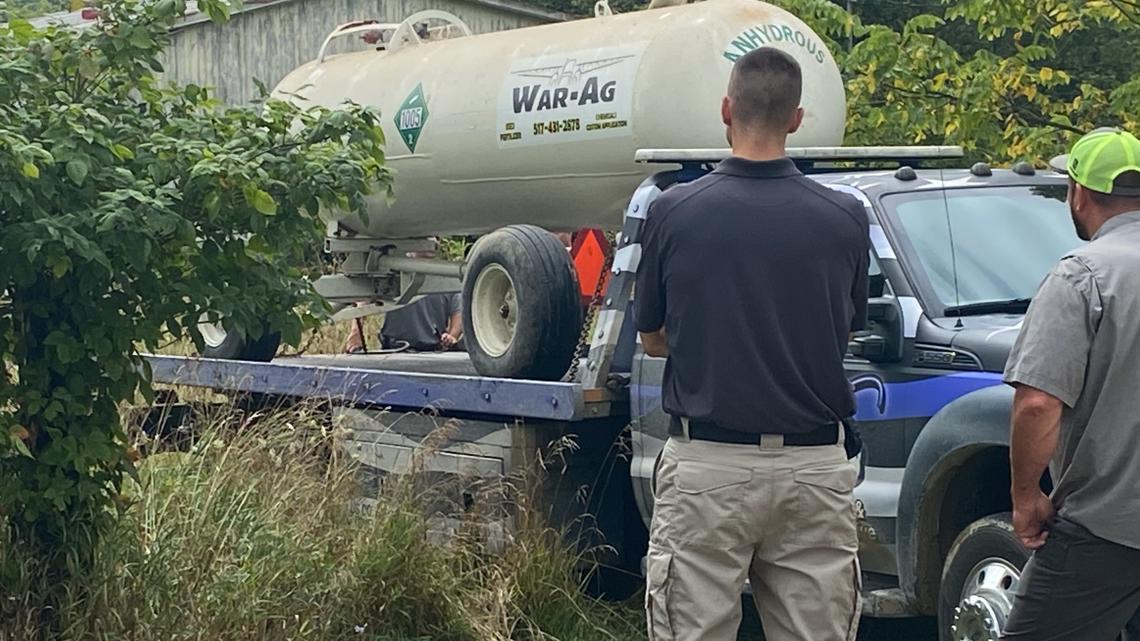TIPTON, Mich. — Anhydrous ammonia is one of the most widely used industrial chemicals in the U.S. according to the American Chemical Society. The colorless gas composed of nitrogen and hydrogen (NH₃) is used in agriculture and various industrial processes.
According to investigators into the disappearance of Dee Warner, human remains were found in an anhydrous ammonia tank on a property belonging to her husband, who is charged in her death.
An autopsy is scheduled for Tuesday, Aug. 20 for a formal identification of the remains, according to the Michigan State Police. But a spokesman for the family says they believe the remains to be those of Dee Warner.
RELATED: Full timeline of Dee Warner's case
Questions now arise around what anhydrous ammonia is used for and why it's stored in tanks, which look similar to large propane tanks.
"Anhydrous" means "without water," making it different from aqueous ammonia, which is a solution of ammonia in water. In its purest form, anhydrous ammonia is a pungent, caustic gas, but it is usually stored and transported as a liquid under high pressure.
How is anhydrous ammonia used?
The primary use of anhydrous ammonia is in agriculture, where it serves as a high-efficiency nitrogen fertilizer. It provides plants with a readily available form of nitrogen, needed for growth. Generally, farmers inject it directly into the soil, where it dissolves and reacts with water to form ammonium, which plants can easily absorb.
Apart from agriculture, anhydrous ammonia is a key component in the production of nitric acid, a precursor to many fertilizers and explosives. It's also used in refrigeration systems, particularly in industrial settings, due to its high efficiency as a coolant. Additionally, anhydrous ammonia is involved in the manufacture of plastics, dyes and other chemicals.
How is anhydrous ammonia stored?
Because of its caustic and volatile nature, anhydrous ammonia is stored under high pressure in specially designed containers, typically made of steel. These containers are maintained at a temperature below its boiling point, which is -33°C (-28°F), to keep it in a liquid state. Storage tanks are equipped with safety features, including pressure relief valves, to prevent over-pressurization.
Transportation of anhydrous ammonia is also done under high pressure in specialized tanks, often via rail, truck or pipeline. The transportation and storage of anhydrous ammonia are strictly regulated due to the risks associated with its volatility and potential for harm in the event of a leak or spill.
What effect does anhydrous ammonia exposure have on humans?
According to the National Institute for Occupational Safety and Health, exposure to anhydrous ammonia can have severe health effects, depending on the concentration and duration of exposure.
At lower concentrations, ammonia gas is a strong irritant to the eyes, skin and respiratory system. Symptoms of exposure include coughing, chest pain and difficulty breathing. Direct contact with the liquid form can cause frostbite and severe chemical burns.
Inhalation of high concentrations can be life-threatening, leading to severe respiratory damage, including lung edema and potentially fatal airway obstruction
The U.S. Environmental Protection Agency calls anhydrous ammonia a poisonous gas that can cause serious health issues and even death if exposed.
Prolonged exposure to high concentrations of anhydrous ammonia vapors can lead to serious lung damage. Other effects of exposure include:
- Temporary blindness and eye damage
- Irritation of the mouth, respiratory tract, and mucous membranes
- Organismal and population level effects, such as reduced growth rate, feeding activity, and fecundity, decreased population size, and increased mortality
Prolonged or repeated exposure may result in chronic respiratory issues and long-term health effects. Immediate medical attention is crucial in cases of significant exposure.
Why were anhydrous ammonia tanks on the property?
While it's unclear the present working state of the anhydrous ammonia tanks on the Warner farm properties, court records show intended plans for a fertilizer and pesticide storage and distribution operation on Warner farm property in the early 2000s.
According to documents filed in Lenawee County Circuit Court, in 2008, Dale and Dee Ann (Bock) Warner submitted an application for conditional use permit to allow them to sell and distribute seed, pesticides and fertilizer from a 20-acre parcel of their property secondary to their farming operation.
They "intended to store fertilizer and pesticides on their property and directly provide those products to farmers located within 10 to 15 miles of their farm, and to sell additional product to other farmers located more than15 miles away, which would be shipped directly from the manufacturer to those distant farmers."
The permit was denied, and the Warners plus WAR-AG Farms, LLC, appealed the decision, suing Franklin Township, Franklin Township Zoning Board Of Appeals and the Franklin Township Planning Commission in October 2008.
The anhydrous ammonia tanks taken from a Warner farm property on Paragon Road on Friday, Aug. 16, bear the War-Ag farm name and are labeled "anhydrous." A spokesman for the Dee Warner family told WTOL 11 on Sunday, Aug. 18, that a body was found in one of the anhydrous tanks.



